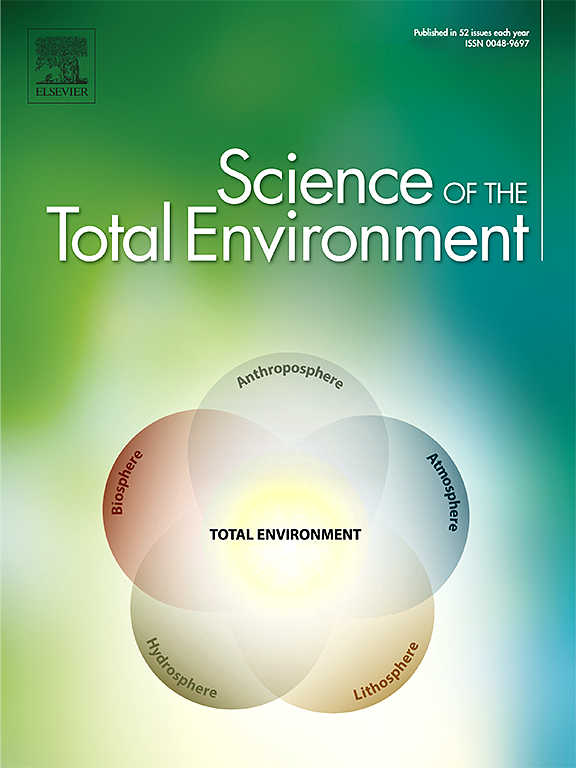IF 8.2
1区 环境科学与生态学
Q1 ENVIRONMENTAL SCIENCES
引用次数: 0
摘要
氯化苯醌(CBQs)是一类广泛存在于水生环境中的消毒副产物(DBPs)。由于其对水生生物和人类具有很强的细胞毒性和基因毒性,识别新型 CBQs 并探索其形成机理成为近年来研究的重点。本研究首次发现了酪氨酸(Tyr)和色氨酸(Trp)这两种芳香族氨基酸在氯化过程中形成的一组新的氯化 DBPs。根据质谱数据推断出了 Tyr 和 Trp 的主要氯化产物二氯对苯醌(DCBQ)的四种主要形成途径,包括亲电加成反应、氯化反应、水解反应、脱羧反应、氧化反应、脱氢氯化反应和吡咯环裂解反应。量子化学计算进一步探讨了 Tyr 可能发生氯化反应生成 2,6-DCBQ 的取代位点。氯化作用往往发生在 Tyr 中 -OH(羟基)基团的正 C 位。Tyr 的 C1 位最容易发生单氯化反应,而单氯化产物的 C5 位更容易发生二氯化反应。此外,Tyr 的氮原子(N18)也可能发生氯取代,但在 C1 和 C5 位点已被取代的情况下很难发生。本研究结合实验和理论结果,总结了氨基酸氯化过程中生成 2,6-DCBQ 的主要途径。研究结果有助于人们更深入地了解氯化副产物对水安全的影响和潜在的健康风险。本文章由计算机程序翻译,如有差异,请以英文原文为准。

Formation mechanisms of chlorinated disinfection byproducts chlorinated benzoquinones from free aromatic amino acids: In vitro and in silico study
Chlorinated benzoquinones (CBQs) are a class of disinfection byproducts (DBPs) that are widely present in aquatic environments. Due to their strong cytotoxicity and genotoxicity to aquatic organisms and humans, the identification of novel CBQs and the exploration of their formation mechanisms became the focus of recent research. In this study, a new group of chlorinated DBPs formed during chlorination of two aromatic amino acids, tyrosine (Tyr) and tryptophan (Trp), were identified for the first time. Four predominant formation pathways of the main chlorinated product from Tyr and Trp, dichloro-benzoquinone (DCBQ), were deduced based on the MASS spectrum data, which consist of reactions including electrophilic addition, chlorination, hydrolysis, decarboxylation, oxidation, dehydrochlorination, and cleavage of the pyrrole ring. The potential chlorination substituted sites of Tyr to form 2,6-DCBQ were further explored by quantum chemical calculations. Chlorination tended to occur at the ortho C-position of the –OH (hydroxyl) group in Tyr. The C1 site of Tyr was most prone to undergo monochlorination, and dichlorination was more likely to take place at C5 site of the monochlorinated product. In addition, the nitrogen atom (N18) of Tyr could also undergo chlorine substitution, but it was difficult to happen when the C1 and C5 sites were already substituted. By combining experimental and theoretical results, this study summarized the predominant pathway for the formation of 2,6-DCBQ during the chlorination process of amino acids. The outcome contributed to a deeper understanding of the implications for water safety and the potential health risks associated with chlorination byproducts.
求助全文
通过发布文献求助,成功后即可免费获取论文全文。
去求助
来源期刊

Science of the Total Environment
环境科学-环境科学
CiteScore
17.60
自引率
10.20%
发文量
8726
审稿时长
2.4 months
期刊介绍:
The Science of the Total Environment is an international journal dedicated to scientific research on the environment and its interaction with humanity. It covers a wide range of disciplines and seeks to publish innovative, hypothesis-driven, and impactful research that explores the entire environment, including the atmosphere, lithosphere, hydrosphere, biosphere, and anthroposphere.
The journal's updated Aims & Scope emphasizes the importance of interdisciplinary environmental research with broad impact. Priority is given to studies that advance fundamental understanding and explore the interconnectedness of multiple environmental spheres. Field studies are preferred, while laboratory experiments must demonstrate significant methodological advancements or mechanistic insights with direct relevance to the environment.
 求助内容:
求助内容: 应助结果提醒方式:
应助结果提醒方式:


